jdowning
Oud Junkie
    
Posts: 3485
Registered: 8-2-2006
Location: Ontario, Canada
Member Is Offline
Mood: No Mood
|
|
Bending Ribs using Slip Rolls?
ExtreamTarab has recently brought our attention to a video showing a luthier bending the ribs of an oud bowl by passing them through what appears to
be a set of hand operated rollers.
This topic is an investigation into the practical value of this method using a set of tinsmith's slip rolls to form the ribs.
Slip rolls are used by sheet metal worker to form thin metal such as tinplate into uniform curved shapes or into cylinders.
The machine consists of two gear driven 'feed' rollers that rotate in opposite directions to each other. The gap between the rolls can be adjusted to
suite different metal thicknesses. Behind the gear driven 'feed' rolls is a third freely rotating idler roll adjustable to apply pressure to the sheet
metal as it exits the the 'feed' rolls forcing the metal into a curved profile.
The attached sketch and images illustrate the operating principle and details of the machine forming a strip of tinplate into a cylinder. The machine
is called 'slip' rolls due to the fact that the upper feed roll may be released and hinged upwards allowing formed cylinders to be conveniently slid
or slipped off the open end of the upper feed roll.
So much for forming metal. Next to find out what happens if we try to bend wooden strips with this machine.
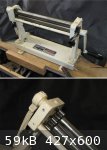
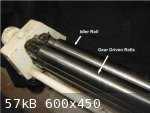

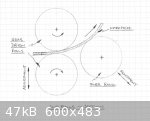
|
|
|
jdowning
Oud Junkie
    
Posts: 3485
Registered: 8-2-2006
Location: Ontario, Canada
Member Is Offline
Mood: No Mood
|
|
The first trial has been to attempt to cold bend dry wooden test blanks.
The test blanks are old rib 'off cuts' that happened to be lying under the bench these being Black Walnut 1.8 mm thick, Ash 1.8 mm thick, Elm 1.0 mm
thick and Curly Maple 1.5 mm thick. The Walnut and Ash samples are over 100 years old.
The slip rolls were set to apply pressure to each blank with the rear idling roller moved out of the way so that it did not participate in the bending
process. Bending was achieved by manually forcing the blank upwards as it came out of the rolls (the geared rolls can work in both directions so the
each blank was moved back and forth through the rolls as bending progressed).
As can be seen from the images only the Ash was successfully bent to a curvature sufficient for making an oud bowl.
Furthermore the rolling pressure reduced the thickness of the Ash blank from 1.8 mm to a uniform 1.5 mm thickness.
The Walnut being harder than the Ash was more difficult to bend without cracking so only a limited amount of curvature was achieved with no
significant reduction in thickness.
The thinner Elm blank was bent to a greater curvature than the Walnut as was the Curly Maple however the Maple cracked during the bending process.
So cold bending would appear work if the wood is relatively soft and straight grained so that it will yield under the pressure of the rolls without
cracking.
Bending harder woods might be possible if the wood is temporarily softened prior to bending by soaking the wood for a period of time in hot water
and/or in a 'marinade' of ammonia/alcohol. Heating the wood with a hot air gun would be unlikely to work due to the immediate cooling of the wood as
it is passed through the cold steel rolls.
Next to test some softened wood samples.
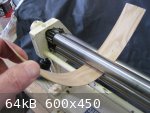

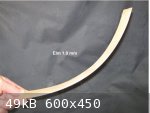
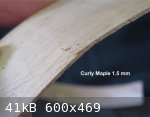
|
|
|
jdowning
Oud Junkie
    
Posts: 3485
Registered: 8-2-2006
Location: Ontario, Canada
Member Is Offline
Mood: No Mood
|
|
Samples of quarter sawn Walnut and Maple measuring 4 cm wide by 1.9 mm thick were soaked in water for 24 hours and then immersed in boiling water for
5 minutes before being compressed and bent in the slip rolls.
The Maple sample failed to take a longitudinal curvature and cracked transversely in two places.
Walnut sample A on the other hand - after boiling - had the consistency of wet leather and so was easily bent into a complete smooth loop with a
radius of about 3 cm. It could likely have been bent further to a smaller radius. During bending, the sample was reduced in thickness from 1.9 mm to
1.6 mm by being compressed through the rolls.
For comparison, another piece of Walnut 1.9 mm thick (sample B) was again boiled in water for 5 minutes before being bent free hand (i.e. not using
the slip rolls). This sample could not be bent as easily or uniformly and began to crack before it could be formed into a complete loop.
Both Walnut samples were tied up with string and allowed to dry after which they fully retained their bent shape (in fact the compressed sample A
dried to a slightly tighter loop).
This is an interesting result.
When bent, softened wood will only stretch by about 1.5% in tension (outside face of the curve) before failure occurs whereas softening the wood
increases compressibility (inside face of the curve) by up to 30% before failure occurs.
Sample B could likely have been bent, freehand, into a smooth complete loop if the outside face had been supported with a thin metal strap - a
standard method used when steam bending wood.
It might, therefore, be concluded that when wood is bent under localised compression forces (i.e. using slip rolls) that the pressure of the rolls
provides sufficient uniform support to prevent tensile failure of the wood fibres in the outer surfaces (and may also increase the degree of
compression that can be carried by the inside surfaces?).
The wood species that bend well when boiled in water (or steamed) include Ash, Hickory, Beech, Walnut, Birch, and Elm - but not Maple or tropical
hardwoods such as Rosewood.
More to follow.
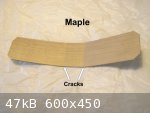
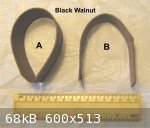
|
|
|
jdowning
Oud Junkie
    
Posts: 3485
Registered: 8-2-2006
Location: Ontario, Canada
Member Is Offline
Mood: No Mood
|
|
The attached plot Yield Test #2 (previously posted on the forum) shows that simply soaking Walnut in water does very little to soften the wood after
an initial immersion of 24 hours whereas boiling the wood sample for 5 minutes produced maximum softening of the wood fibres.
A sample of Walnut and Maple have been soaking in a marinade solution of 50% Household Ammonia/ 50% Methyl Alcohol. From past experiments, this
marinade gives a slower, more controlled softening action on the wood fibres than household Ammonia (10% solution or 5% solution).
After soaking for 4 days, the samples had absorbed the marinade but were still quite stiff to bend. The samples were then quickly rinsed with hot tap
water to removed any marinade on the surface and passed through the slip rolls. When compressed by the rolls much of the absorbed marinade was
squeezed out and the samples then became very flexible and could be easily bent into a tight curvatures as can be seen in the attached image.
After drying, the samples maintained their curved shape and were found to have been reduced in thickness to 1.6 mm - about a 15% reduction from their
original thickness of 1.9 mm.
Note that as a 4 day period of soaking should not result in a significant softening of the samples - the flexibility is produced by compressing the
wood fibres.
It will now be of interest to repeat the prosses of soaking Walnut and Maple samples in marinade for a longer period of time to determine how much
more flexibility of the wood might occur under compression. Sufficient to be able to form deeply fluted oud ribs perhaps?
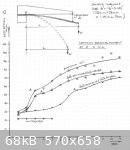

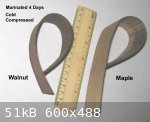
|
|
|
jdowning
Oud Junkie
    
Posts: 3485
Registered: 8-2-2006
Location: Ontario, Canada
Member Is Offline
Mood: No Mood
|
|
To complete these trials the marinated/compressed/bent and dried samples were immersed in warm water for about 15 minutes. As the samples absorbed
water they opened out and regained their extreme flexibility so could easily be bent back into its original shape by hand. After clamping and drying
again for 24 hours each sample had hardened and retained its original shape.
The attached image shows the Maple sample after soaking prior to re bending to ts original curvature.
From these tests it is concluded that, after soaking in marinade, physically compressing the wood fibres makes the wood very flexible so that it can
be easily bent into very tight curves - the bent shape being retained upon drying. Furthermore, the process is reversible - the flexibility returning
by simply re-soaking the wood in warm water.
This method would have a useful application in allowing a quick and precise shaping of ribs by placing them - after compression - over a mold and
allowing them to dry. The ribs should then retain their shape without any 'spring back'.
This procedure will only work with air dried wood, however.
In kiln dried wood the higher temperatures involved softens the natural 'glue' (Lignin) that binds the wood cells together producing a permanent 'set'
of the wood that cannot be completely reversed by boiling (or steaming).
Likewise, the traditional method of hot bending ribs produces a permanent set of the wood cell structure - presumably, therefore, ribs bent in this
traditional way are more resistant to humidity changes?
The possibility of producing deeply fluted ribs by this compression method has yet to be tested.

|
|
|